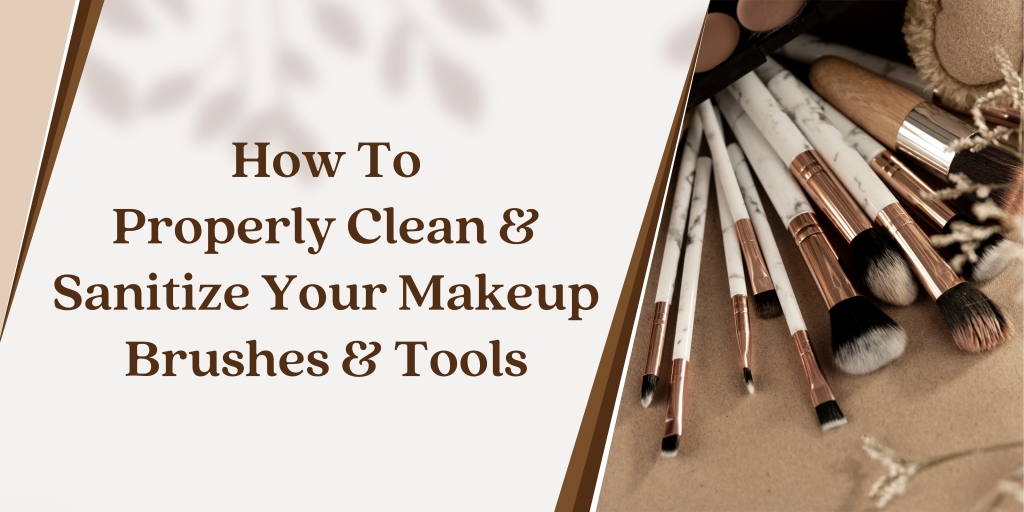
As a cosmetics fan, you probably know the significance of having perfect and very much kept up with cosmetics brushes and instruments. They not only make your brushes better and last longer, but they also help keep bacteria from making your skin irritated and prone to breakouts. Makeup brushes and other tools should be cleaned and sanitized as part of your beauty routine to ensure that they are in top condition for each use. A comprehensive guide on how to clean and disinfect makeup tools is provided here.
Step 1: Cleaning
Cleaning your makeup brushes is the first step in keeping them in good condition. A gentle soap or specialized brush cleaner are required for this. Swirl the brush’s bristles in the soap or cleaner after wetting them with lukewarm water. Avoid getting the brush’s handle wet because doing so may eventually cause it to become loose. Under running water, thoroughly rinse the bristles to remove any soap or cleaner. Adjust the shape of the brush by gently squeezing out any excess water. To let the brush air dry, lay it flat on a clean towel. Keep doing this for each and every one of your tools and brushes.
It is fundamental for clean your cosmetics brushes routinely. You should clean your brushes at least once a week if you use them frequently. You can clean them once every two weeks if you use them less often. If you don’t clean your brushes often, makeup, oil, and bacteria can build up, causing breakouts, irritation, and even infections.
Step 2: Disinfecting
Once your brushes have been cleaned, it’s time to disinfect them. Disinfecting the brush is a must for good hygiene because it helps kill any germs or bacteria that are still on it. Utilizing a brush sanitizer or a disinfectant spray are two options for disinfecting your brushes. Simply apply the disinfectant to the brush’s bristles and allow them to air dry. You can also disinfect the bristles by dipping them in 70% isopropyl alcohol and letting them sit for a few minutes before rinsing and air-drying.
It is essential to keep in mind that cleaning your brushes before disinfecting them is not an alternative. If you share your brushes with others, you should disinfect them after each use. Brush sharing can result in the transmission of germs and bacteria that can cause infections.
Step 3: Cleansing
For added security and to guarantee greatest sanitization, you can likewise clean your brushes in bubbling water. Put water in a pot and bring it to a boil. Ensure that the bristles are completely submerged when dipping the brushes in the boiling water for two to three minutes. Eliminate the brushes from the water and let them air dry on a perfect towel.
Brushes should be sterilized once per month. If you have used your brushes on someone who has an infection or if you have had an eye infection yourself, sterilization is especially important. Before sterilizing your brushes, be sure to check the instructions provided by the manufacturer because some brushes are not suitable for boiling.
Step 4: Proper storage
After your brushes have completely dried, it is essential to store them in an appropriate manner to prevent further contamination. Store your brushes upward in a cup or holder to keep the fibers from becoming distorted. They should be kept dry, clean, and away from direct sunlight and moisture.
If you want your brushes to keep their shape and quality, you need to store them properly. Your brushes may not work as well or even cause streaking or smudging if they lose their shape.
Step 5: Cleaning frequency
Depending on how frequently you use your makeup tools and brushes, you should clean them more often. It is suggested that you clean brushes that you use every day at least once a week. You can clean less frequently used brushes once or twice a month or every two weeks. In order to stop the spread of germs and bacteria, it is also absolutely necessary to clean your brushes after using them on another person or after getting sick.
Step 6: Avoiding common blunders
When cleaning your brushes, it’s critical to avoid a few common blunders that can cause damage to the bristles and shorten their useful life. Try not to utilize boiling water, as it can harm the paste keeping the fibers intact. Never absorb your brushes water or cleaner for a drawn out period, as it can make the fibers drop out. Last but not least, do not dry your brushes with a hairdryer or any other heating tool because doing so could harm the bristles and cause them to lose their shape.
Step 7: Sponge cleaning
Cleaning your makeup sponges on a regular basis is just as important as brush cleaning. Sponges are great for applying liquid makeup like foundation, concealer, and lipstick, but if they aren’t cleaned properly, they can also hold germs and bacteria. Use lukewarm water and a small amount of soap or cleanser to clean your makeup sponge. Focus on the areas of the sponge that have the most product buildup and massage it gently. Flush the wipe completely under running water until the water runs clear. Let the sponge air dry on a clean towel after you squeeze out any excess water.
Step 8: Cleaning wipes
Like brushes, it’s critical to disinfect your cosmetics wipes to eliminate any leftover microbes or microorganisms. Spray disinfectant or a specialized sponge cleaner are two options. Apply the disinfectant to the sponge and allow it to air dry. You can likewise utilize 70% isopropyl liquor to clean your wipe. After soaking the sponge for a few minutes in the alcohol, thoroughly rinse it under running water. Let the sponge air dry after you squeeze out any excess water.
Step 9: Supplanting old brushes and wipes
While cleaning and disinfecting your brushes and wipes is significant, it’s additionally critical to routinely supplant them. Brushes’ bristles and sponges can begin to break down over time, making them less effective and more susceptible to bacteria growth. Depending on how frequently you use your brushes and sponges, it is recommended that you replace them every six months to a year.
In conclusion, an essential part of any beauty routine is keeping makeup tools and brushes clean and sanitized. By following these straightforward advances, you can guarantee that your brushes and wipes are in top condition, which won’t just work on their life span yet in addition safeguard your skin from aggravation and breakouts brought about by microscopic organism’s development. You’ll be on your way to flawless makeup application and healthy skin if you remember to regularly clean and sanitize your brushes and sponges, store them properly, and replace them when necessary.

1 thought on ““How to properly clean and sanitize your makeup brushes and tools””